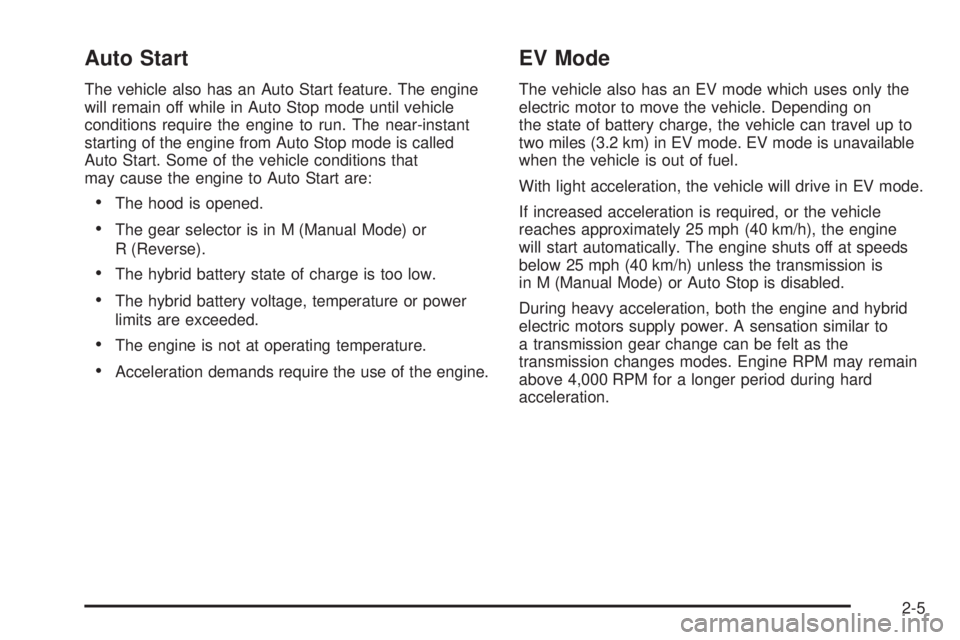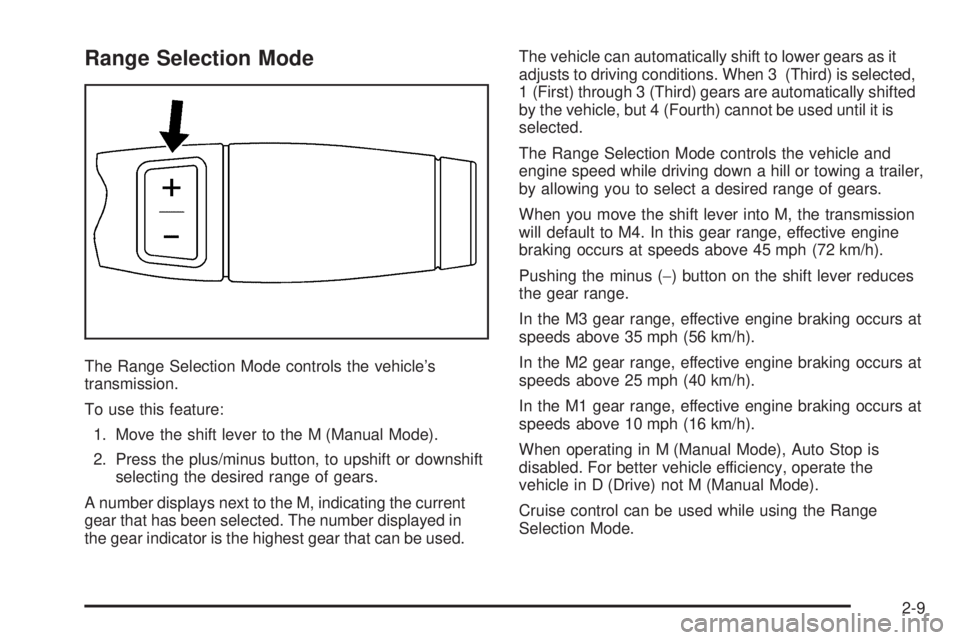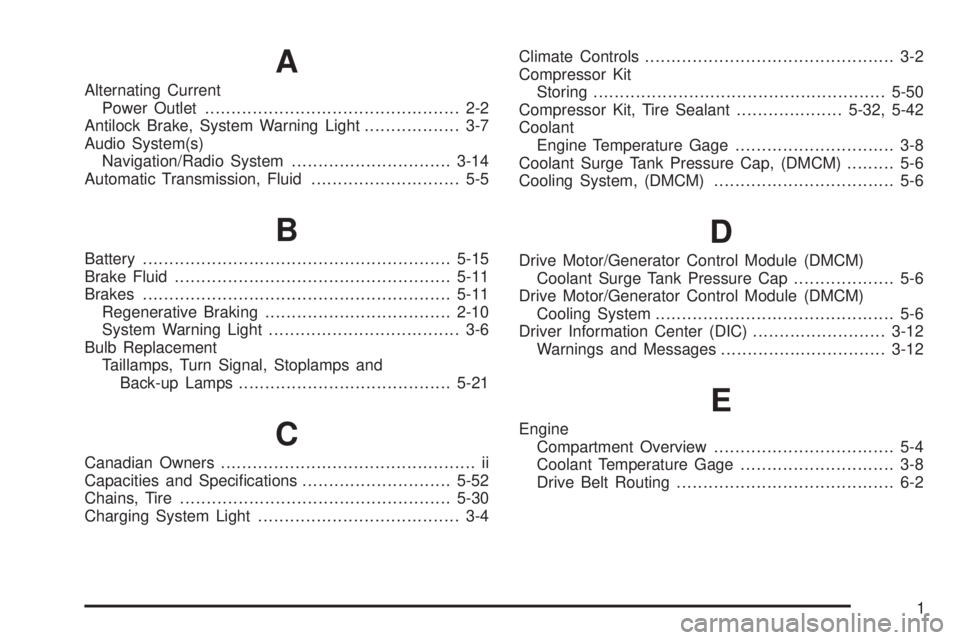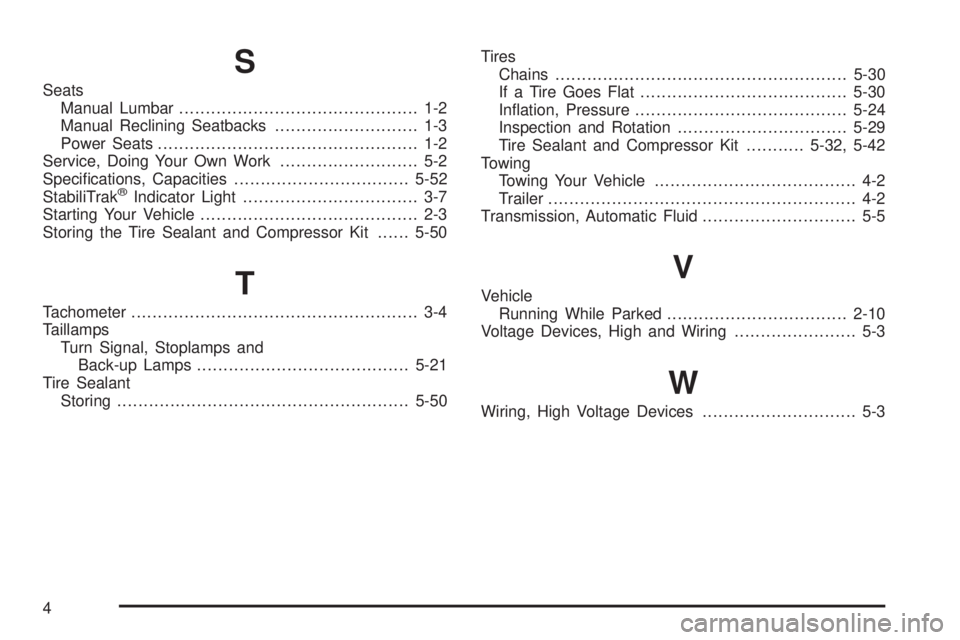automatic transmission GMC YUKON HYBRID 2009 Owners Manual
[x] Cancel search | Manufacturer: GMC, Model Year: 2009, Model line: YUKON HYBRID, Model: GMC YUKON HYBRID 2009Pages: 94, PDF Size: 0.53 MB
Page 9 of 94

Storage Areas..................................................2-2
Power Outlet Alternating Current.......................2-2Starting and Operating Your Vehicle.................2-3
Starting the Vehicle........................................2-3
Automatic Transmission Operation....................2-6
Regenerative Braking....................................2-10
Running the Vehicle While Parked..................2-10
Section 2 Features and Controls
2-1
Page 13 of 94

Auto Start
The vehicle also has an Auto Start feature. The engine
will remain off while in Auto Stop mode until vehicle
conditions require the engine to run. The near-instant
starting of the engine from Auto Stop mode is called
Auto Start. Some of the vehicle conditions that
may cause the engine to Auto Start are:
•The hood is opened.
•The gear selector is in M (Manual Mode) or
R (Reverse).
•The hybrid battery state of charge is too low.
•The hybrid battery voltage, temperature or power
limits are exceeded.
•The engine is not at operating temperature.
•Acceleration demands require the use of the engine.
EV Mode
The vehicle also has an EV mode which uses only the
electric motor to move the vehicle. Depending on
the state of battery charge, the vehicle can travel up to
two miles (3.2 km) in EV mode. EV mode is unavailable
when the vehicle is out of fuel.
With light acceleration, the vehicle will drive in EV mode.
If increased acceleration is required, or the vehicle
reaches approximately 25 mph (40 km/h), the engine
will start automatically. The engine shuts off at speeds
below 25 mph (40 km/h) unless the transmission is
in M (Manual Mode) or Auto Stop is disabled.
During heavy acceleration, both the engine and hybrid
electric motors supply power. A sensation similar to
a transmission gear change can be felt as the
transmission changes modes. Engine RPM may remain
above 4,000 RPM for a longer period during hard
acceleration.
2-5
Page 14 of 94

Automatic Transmission Operation
The vehicle has an electronic shift position indicator
within the instrument panel cluster.
There are several different positions for the shift lever.
See “Range Selection Mode” later in this section.
P (Park):This position locks the rear wheels. It is the
best position to use when you start the engine because
the vehicle cannot move easily.
When parked on a hill, especially when the vehicle
has a heavy load, you may notice an increase in the
effort to shift out of P (Park). See “Shifting Into P (Park)”
in the Index of vehicle’s owner manual for more
information.{CAUTION:
It is dangerous to get out of the vehicle if the shift
lever is not fully in P (Park) with the parking brake
firmly set. The vehicle can roll.
Do not leave the vehicle when the engine is
running unless you have to. If you have left the
engine running, the vehicle can move suddenly.
You or others could be injured. To be sure the
vehicle will not move, even when you are on fairly
level ground, always set the parking brake and
move the shift lever to P (Park). See Shifting Into
Park in the Owner Manual. If you are pulling a
trailer, seeTowing a Trailer on page 4-2.
2-6
Page 17 of 94

Range Selection Mode
The Range Selection Mode controls the vehicle’s
transmission.
To use this feature:
1. Move the shift lever to the M (Manual Mode).
2. Press the plus/minus button, to upshift or downshift
selecting the desired range of gears.
A number displays next to the M, indicating the current
gear that has been selected. The number displayed in
the gear indicator is the highest gear that can be used.The vehicle can automatically shift to lower gears as it
adjusts to driving conditions. When 3 (Third) is selected,
1 (First) through 3 (Third) gears are automatically shifted
by the vehicle, but 4 (Fourth) cannot be used until it is
selected.
The Range Selection Mode controls the vehicle and
engine speed while driving down a hill or towing a trailer,
by allowing you to select a desired range of gears.
When you move the shift lever into M, the transmission
will default to M4. In this gear range, effective engine
braking occurs at speeds above 45 mph (72 km/h).
Pushing the minus (−) button on the shift lever reduces
the gear range.
In the M3 gear range, effective engine braking occurs at
speeds above 35 mph (56 km/h).
In the M2 gear range, effective engine braking occurs at
speeds above 25 mph (40 km/h).
In the M1 gear range, effective engine braking occurs at
speeds above 10 mph (16 km/h).
When operating in M (Manual Mode), Auto Stop is
disabled. For better vehicle efficiency, operate the
vehicle in D (Drive) not M (Manual Mode).
Cruise control can be used while using the Range
Selection Mode.
2-9
Page 37 of 94

Service............................................................5-2
Doing Your Own Service Work.........................5-2
Checking Things Under the Hood.....................5-3
High Voltage Devices and Wiring......................5-3
Engine Compartment Overview.........................5-4
Automatic Transmission Fluid...........................5-5
Drive Motor/Generator Control Module (DMCM)
Coolant Surge Tank Pressure Cap..................5-6
Drive Motor/Generator Control Module (DMCM)
Cooling System...........................................5-6
Power Steering Fluid.....................................5-11
Brakes........................................................5-11
Battery........................................................5-15
Jump Starting...............................................5-16
Bulb Replacement..........................................5-21
Taillamps, Turn Signal, Stoplamps and
Back-up Lamps.........................................5-21
Replacement Bulbs.......................................5-22Electrical System............................................5-22
Fuses and Circuit Breakers............................5-22
Underhood Fuse Block..................................5-22
Tires..............................................................5-24
Inflation - Tire Pressure.................................5-24
Tire Pressure Monitor Operation.....................5-25
Tire Inspection and Rotation...........................5-29
Tire Chains..................................................5-30
If a Tire Goes Flat........................................5-30
Tire Sealant and Compressor Kit
(Without Selector Switch)............................5-32
Tire Sealant and Compressor Kit
(With Selector Switch)................................5-42
Tire Sealant and Compressor Kit Storage.........5-50
Capacities and Speci�cations..........................5-52
Section 5 Service and Appearance Care
5-1
Page 41 of 94

A. See “Engine Air Cleaner/Filter” in the owner manual.
B. Drive Motor/Generator Control Module (DMCM).
SeeDrive Motor/Generator Control Module (DMCM)
Cooling System on page 5-6.
C. Engine Oil Dipstick. See “Engine Oil” in the owner
manual.
D. Automatic Transmission Fluid Dipstick. See
Automatic Transmission Fluid on page 5-5.
E. Brake Fluid Reservoir. SeeBrakes on page 5-11.
F. See “Underhood Fuse Block” in the owner manual.
G. See “Windshield Washer Fluid” in the owner
manual.
H. Hybrid Auxiliary Fuse Block. SeeUnderhood Fuse
Block on page 5-22.
I. DMCM Coolant Surge Tank Pressure Cap. See
Drive Motor/Generator Control Module (DMCM)
Coolant Surge Tank Pressure Cap on page 5-6.
J. See “Coolant Surge Tank Pressure Cap” in
the owner manual.
K. Engine Oil Fill Cap. See “Engine Oil” in the owner
manual.Automatic Transmission Fluid
For more information, see “Automatic Transmission
Fluid” in the owner manual Index.
Checking the Fluid Level
Your vehicle’s automatic transmission dipstick looks like
this. For more information on location, seeEngine
Compartment Overview on page 5-4.
5-5
Page 52 of 94

Jump Starting
If the vehicle’s 12-volt battery has run down, you may
want to use another vehicle and some jumper cables
to start your vehicle. Use the following steps to do
it safely.
{CAUTION:
Batteries can hurt you. They can be dangerous
because:
•They contain acid that can burn you.
•They contain gas that can explode or ignite.
•They contain enough electricity to burn you.
If you do not follow these steps exactly, some or
all of these things can hurt you.Notice:Ignoring these steps could result in costly
damage to the vehicle that would not be covered
by the warranty.
Trying to start the vehicle by pushing or pulling it
will not work, and it could damage the vehicle.
1. Check the other vehicle. It must have a 12-volt
battery with a negative ground system.
Notice:If the other vehicle’s system is not a 12-volt
system with a negative ground, both vehicles can
be damaged. Only use vehicles with 12-volt systems
with negative grounds to jump start your vehicle.
2. Get the vehicles close enough so the jumper cables
can reach, but be sure the vehicles are not touching
each other. It could cause a ground connection
you do not want. You would not be able to start your
vehicle, and the bad grounding could damage the
electrical systems.
To avoid the possibility of the vehicles rolling, set
the parking brake firmly on both vehicles involved
in the jump start procedure. Put the automatic
transmission in P (Park) or a manual transmission
in N (Neutral) before setting the parking brake.
If you have a four-wheel-drive vehicle, be sure the
transfer case is in a drive gear, not in N (Neutral).
5-16
Page 91 of 94

A
Alternating Current
Power Outlet................................................ 2-2
Antilock Brake, System Warning Light.................. 3-7
Audio System(s)
Navigation/Radio System..............................3-14
Automatic Transmission, Fluid............................ 5-5
B
Battery..........................................................5-15
Brake Fluid....................................................5-11
Brakes..........................................................5-11
Regenerative Braking...................................2-10
System Warning Light.................................... 3-6
Bulb Replacement
Taillamps, Turn Signal, Stoplamps and
Back-up Lamps........................................5-21
C
Canadian Owners................................................ ii
Capacities and Specifications............................5-52
Chains, Tire...................................................5-30
Charging System Light...................................... 3-4Climate Controls............................................... 3-2
Compressor Kit
Storing.......................................................5-50
Compressor Kit, Tire Sealant....................5-32, 5-42
Coolant
Engine Temperature Gage.............................. 3-8
Coolant Surge Tank Pressure Cap, (DMCM)......... 5-6
Cooling System, (DMCM).................................. 5-6
D
Drive Motor/Generator Control Module (DMCM)
Coolant Surge Tank Pressure Cap................... 5-6
Drive Motor/Generator Control Module (DMCM)
Cooling System............................................. 5-6
Driver Information Center (DIC).........................3-12
Warnings and Messages...............................3-12
E
Engine
Compartment Overview.................................. 5-4
Coolant Temperature Gage............................. 3-8
Drive Belt Routing......................................... 6-2
1
Page 94 of 94

S
Seats
Manual Lumbar............................................. 1-2
Manual Reclining Seatbacks........................... 1-3
Power Seats................................................. 1-2
Service, Doing Your Own Work.......................... 5-2
Specifications, Capacities.................................5-52
StabiliTrak
®Indicator Light................................. 3-7
Starting Your Vehicle......................................... 2-3
Storing the Tire Sealant and Compressor Kit......5-50
T
Tachometer...................................................... 3-4
Taillamps
Turn Signal, Stoplamps and
Back-up Lamps........................................5-21
Tire Sealant
Storing.......................................................5-50Tires
Chains.......................................................5-30
If a Tire Goes Flat.......................................5-30
Inflation, Pressure........................................5-24
Inspection and Rotation................................5-29
Tire Sealant and Compressor Kit...........5-32, 5-42
Towing
Towing Your Vehicle...................................... 4-2
Trailer.......................................................... 4-2
Transmission, Automatic Fluid............................. 5-5
V
Vehicle
Running While Parked..................................2-10
Voltage Devices, High and Wiring....................... 5-3
W
Wiring, High Voltage Devices............................. 5-3
4